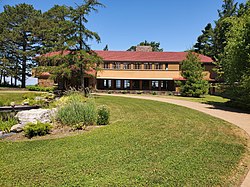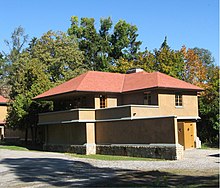
Frank Lloyd Wright was an American architect, designer, writer, and educator. He designed more than 1,000 structures over a creative period of 70 years. Wright played a key role in the architectural movements of the twentieth century, influencing architects worldwide through his works and hundreds of apprentices in his Taliesin Fellowship. Wright believed in designing in harmony with humanity and the environment, a philosophy he called organic architecture. This philosophy was exemplified in Fallingwater (1935), which has been called "the best all-time work of American architecture".

Fallingwater is a house designed by the architect Frank Lloyd Wright in 1935 in the Laurel Highlands of southwest Pennsylvania, about 70 miles (110 km) southeast of Pittsburgh in the United States. It is built partly over a waterfall on Bear Run in the Mill Run section of Stewart Township, Pennsylvania. The house was designed to serve as a weekend retreat for Liliane and Edgar J. Kaufmann, the owner of Pittsburgh's Kaufmann's Department Store.

The Darwin D. Martin House Complex is a historic house museum in Buffalo, New York. The property's buildings were designed by renowned architect Frank Lloyd Wright and built between 1903 and 1905. The house is considered to be one of the most important projects from Wright's Prairie School era.

Prairie School is a late 19th and early 20th-century architectural style, most common in the Midwestern United States. The style is usually marked by horizontal lines, flat or hipped roofs with broad overhanging eaves, windows grouped in horizontal bands, integration with the landscape, solid construction, craftsmanship, and discipline in the use of ornament. Horizontal lines were thought to evoke and relate to the wide, flat, treeless expanses of America's native prairie landscape.

The George F. Barton House was designed by Frank Lloyd Wright, built 1903–1904, and is located at 118 Summit Avenue in Buffalo, New York. The Barton House is part of the larger Darwin D. Martin House Complex, considered to be one of the most important projects from Wright's Prairie School era.

Blue Sky Mausoleum, in Forest Lawn Cemetery in Buffalo, New York, is the 2004 completion of a 1928 design by Frank Lloyd Wright as a commercial cemetery project. The design was completed by a one-time apprentice to Wright, Anthony Puttnam.
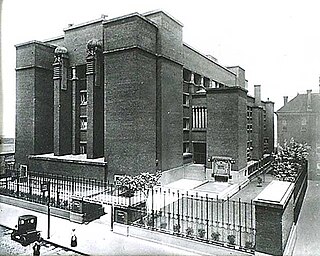
The Larkin Building was an office building in Buffalo, New York, noted for innovations that included central air conditioning, built-in desk furniture, and suspended toilet partitions and bowls. Located at 680 Seneca Street, it was demolished in 1950.

The E-Z Polish Factory is the only factory building designed by Frank Lloyd Wright and is located in Chicago, Illinois, United States at 3005 West Carroll Avenue. The E-Z Polish Company made polish for shoes and stoves. The building now serves as practice space for local bands and artists.
Richard W. Bock was an American sculptor and associate of Frank Lloyd Wright.

The Frank L. Smith Bank, now known as the Dwight Banking Center ofPeoples National Bank of Kewanee, is a bank building in Dwight, Illinois, United States that was designed by American architect Frank Lloyd Wright. Wright's earliest designs for the building date to 1904, but it was constructed in 1905 and opened in 1906. The design of the bank building deliberately rejects the classical influences common at the time, and is meant to evoke an air of simple dignity.
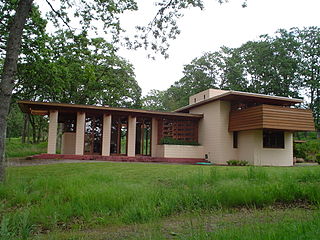
The Gordon House is a residence designed by influential architect Frank Lloyd Wright, now located within the Oregon Garden, in Silverton, Oregon. It is an example of Wright's Usonian vision for America. It is one of the last of the Usonian series that Wright designed as affordable housing for American working class consumers, which—in 1939—were considered to have an annual income of $5,000–6,000. The house is based on a design for a modern home commissioned by Life magazine in 1938.

The Frank J. Baker House is a 4,800-square-foot Prairie School style house located at 507 Lake Avenue in Wilmette, Illinois. The house, which was designed by Frank Lloyd Wright, was built in 1909, and features five bedrooms, three and a half bathrooms, and three fireplaces. At this point in his career, Wright was experimenting with two-story construction and the T-shaped floor plan. This building was part of a series of T-shaped floor planned buildings designed by Wright, similar in design to Wright's Isabel Roberts House. This home also perfectly embodies Wright's use of the Prairie Style through the use of strong horizontal orientation, a low hanging roof, and deeply expressed overhangs. The house's two-story living room features a brick fireplace, a sloped ceiling, and leaded glass windows along the north wall; it is one of the few remaining two-story interiors with the T-shaped floor plan designed by Wright.

Darwin Denice Martin was an early 20th-century New York State businessman best known for the house he commissioned from Frank Lloyd Wright.

Massaro House is an architecturally significant residence on privately owned Petre Island in Lake Mahopac, New York, roughly 50 miles north of New York city. Inspired by architect Frank Lloyd Wright, the home's design and construction have had a complex and controversial history. Wright's plan was initially known as the "Chahroudi House", for the client who commissioned it back in 1949, and for whom Wright designed and built a much smaller cottage on the island when his proposal for the main home proved prohibitively expensive for the local engineer.
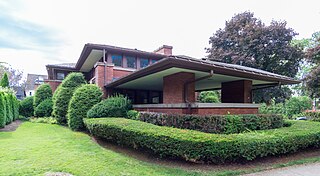
The William R. Heath House was designed by Frank Lloyd Wright, built from 1903 to 1905, and is located at 76 Soldiers Place in Buffalo, New York. It is built in the Prairie School architectural style. It is a contributing property in the Elmwood Historic District–East historic district and a City of Buffalo landmark.

The A. D. German Warehouse is a Frank Lloyd Wright designed Mayan Revival warehouse that was constructed in Richland Center, Wisconsin in 1921. Wright was born in Richland Center in 1867. The building is on the National Register of Historic Places.

The Walter V. Davidson House, located at 57 Tillinghast Place in Buffalo, New York, was designed by Frank Lloyd Wright and built in 1908. It is an example of Wright's Prairie School architectural style. The house is a contributing property to the Parkside East Historic District, a neighborhood laid out by renowned American landscape architect Frederick Law Olmsted in 1876, and also a City of Buffalo landmark.

The Architecture of Buffalo, New York, particularly the buildings constructed between the American Civil War and the Great Depression, is said to have created a new, distinctly American form of architecture and to have influenced design throughout the world.

Lockridge Medical Clinic was a historic building notable for its Prairie School-style design by Frank Lloyd Wright, located in Whitefish, Montana, United States. Originally built as a medical clinic in 1963, the building served a variety of other commercial purposes before it was demolished by its owners in 2018.

The William E. Martin House is a Prairie style home designed in 1902 by American architect Frank Lloyd Wright in the Chicago suburb of Oak Park, Illinois, United States. W.E. Martin was inspired to commission Wright for a home after he and his brother, Darwin D. Martin drove around Oak Park looking at Wright's homes. After meeting with Wright, William Martin excitedly wrote his brother, "I've been—seen—talked to, admired, one of nature's noblemen—Frank Lloyd Wright."
